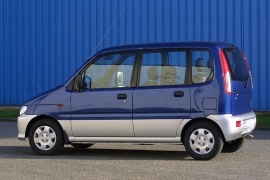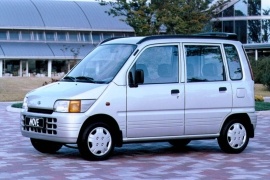DAIHATSU Move Models/Series Timeline, Specifications & Photos
First production year: 1997
Engines: Gasoline
Body style: Hatchback
Daihatsu introduced the Move second generation in late 1998 based on the same platform as a supermini hatchback.
The Japanese carmaker tried to edge over its competitors on the kei-car segment in Japan and hired Giorgetto Giugiaro to pen their MPV. Still, the Japanese rules regarding that segment were stringent. Still, the Italian design company Italdesign managed to create a unique shape for the four-door minivan. At the same time, the Move shared the technical part with another successful Daihatsu product, the Mira/Cuore.
With its flat front fascia and the steep hood, the Move looked different from most competitors, who preferred to make their vehicles with a taller front and a flat hood. Move's rectangular headlights sat slightly behind the front grill, which sported the Daihatsu badge and a horizontal chromed slat. On the lower side of the wrapped-around plastic bumper, the designer installed a lower apron with an additional cooling area. Its sides revealed the flat, vertical side doors with a cut on the lower side for the rear ones to fit around the wheel arches.
Inside, the Move offered enough room for four passengers. Its tall dashboard looked curved, and its shapes were far from the exterior's cubist style. Daihatsu placed the climate controls above the center stack, which was unusual, but installed the audio system lower, above the ashtray and the cigarette lighter. Depending on the market and trim level, the carmaker offered the Move with either a five-speed manual, an automatic, or a CVT transmission.
The 1997 Daihatsu Move was proof of how a small vehicle could be spacious as a mid-size one just by using the more vertical room.
In Japan, the kei-car category was very clear regarding the exterior size and the engine displacement. In 1995, Daihatsu introduced the Move on its home-market and sold 200.000 units before exporting it and made it fit for the European continent.
The Move was the "Form follows function" to the extreme. It was a tall cube with a smaller block in the front, and the whole structure was based on tiny, go-kart 13" wheels. It's flat front fascia with the bumper just slightly in front of the headlights, and the raked line that continued up to the vehicle's roof was the only creative part of the car. The rest of it was composed of flat panels with handles. Even the rear tailgate was side-hinged, which made it difficult to open in tight parking spaces.
Inside, the carmaker installed high-mounted seats, and that led to enough legroom for all the occupants. But there was room only for four since the car's width was not that generous. If a huge traffic jam happened ahead, the driver could have reclined flat all four seats, made a two-people bed inside, and took a nap.
Under the hood, Daihatsu installed a bigger engine than the one offered on the Japanese market. Its 0.8-liter displacement produced just enough power to move the Move in and around cities.

